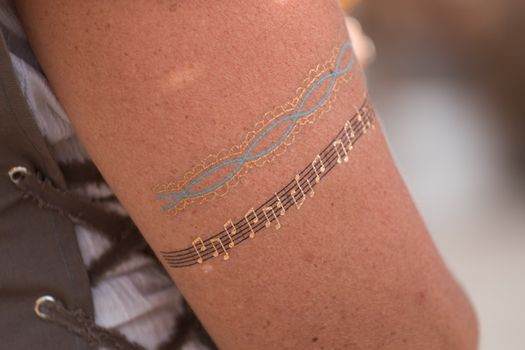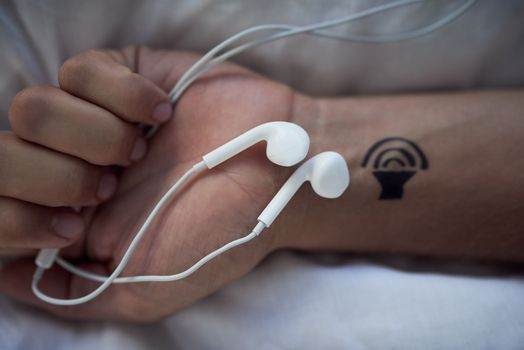In recent years, sound wave tattoos have emerged as a captivating trend within the tattoo industry, captivating both artists and enthusiasts alike. This innovative form of body art allows individuals to immortalize their favorite sounds, voices, or musical notes in a visually striking manner. The concept of translating sound into a visual medium has sparked a wave of creativity, leading to a surge in popularity among those seeking unique and personal tattoos.
As technology advances, the ability to capture and represent sound waves has become more accessible, making it easier for tattoo artists to create intricate designs that resonate with their clients on a deeper level. The rise of sound wave tattoos can be attributed to a growing desire for personalization in body art. Many people are looking for ways to express their individuality and commemorate significant moments in their lives.
Sound wave tattoos offer a unique solution, allowing individuals to encapsulate cherished memories, such as a loved one’s voice or a favorite song, in a form that is both artistic and meaningful. This trend reflects a broader cultural shift towards valuing personal narratives and experiences, as people seek to tell their stories through the art they choose to wear on their skin.

Key Takeaways
- Sound wave tattoos are a rising trend in the tattoo industry, allowing people to preserve and express meaningful sounds through visual art.
- Sound wave tattoos work by capturing a sound wave pattern of a chosen audio clip and translating it into a visual design that can be tattooed onto the skin.
- Sound wave tattoos offer a unique way to preserve the voices of loved ones, including family members, friends, and even pets, creating a lasting tribute.
- Creating meaningful music tattoos through sound wave designs allows individuals to carry their favorite songs or lyrics with them in a visually striking way.
- Sound wave tattoos serve as a form of expression, allowing individuals to showcase their personal stories, memories, and emotions through sound wave art on their bodies.
How Sound Wave Tattoos Work
Sound wave tattoos are created by converting audio recordings into visual representations of sound waves. This process begins with capturing an audio clip, which can range from a simple phrase spoken by a loved one to a snippet of a favorite song. Once the audio is recorded, specialized software analyzes the sound frequencies and generates a waveform—a graphical representation of the sound’s amplitude over time.
This waveform serves as the foundation for the tattoo design, allowing artists to translate the auditory experience into a visual format. Tattoo artists then take this waveform and adapt it into a tattoo design that fits the client’s vision. The design can be stylized in various ways, incorporating elements such as colors, shapes, or additional imagery that enhances the overall aesthetic.
The versatility of sound wave tattoos means that they can be tailored to suit individual preferences, making each piece truly one-of-a-kind. This fusion of technology and artistry not only results in visually stunning tattoos but also creates a profound connection between the wearer and the sound being represented.
Preserving Voices with Sound Wave Tattoos

One of the most poignant aspects of sound wave tattoos is their ability to preserve voices and sounds that hold significant emotional value. For many individuals, capturing the voice of a loved one—be it a parent, partner, or friend—can serve as a powerful reminder of cherished moments and relationships. By transforming these voices into tattoos, individuals can carry a piece of their loved ones with them wherever they go, creating a lasting tribute that transcends time.
The emotional resonance of sound wave tattoos extends beyond mere aesthetics; they encapsulate memories and feelings that can be revisited at any moment. For instance, someone might choose to tattoo the waveform of their child’s first words or an important message from a family member who has passed away. This act of preservation not only honors the memory of those voices but also provides comfort and solace to the wearer.
In this way, sound wave tattoos become more than just body art; they transform into living memorials that celebrate love, connection, and the enduring power of sound.
Creating Meaningful Music Tattoos
Music has long been a source of inspiration for tattoos, with many individuals opting for designs that reflect their favorite songs or artists. Sound wave tattoos take this concept to new heights by allowing fans to capture the very essence of the music they love in a tangible form. By tattooing the waveform of a beloved song or melody, individuals can create a deeply personal connection to the music that has shaped their lives.
The process of selecting a musical piece for a sound wave tattoo often involves careful consideration. Many people choose songs that hold special significance—perhaps a track that played during a pivotal moment in their lives or one that evokes powerful emotions. The resulting tattoo serves as both an artistic expression and a reminder of the impact that music has had on their journey.
This unique approach to music tattoos not only celebrates personal taste but also highlights the universal language of music and its ability to connect people across different backgrounds and experiences.
Sound Wave Tattoos as a Form of Expression
Sound wave tattoos represent a novel form of self-expression that goes beyond traditional tattoo designs. They allow individuals to convey their identities, values, and experiences through auditory representations that are uniquely theirs. In an age where personal branding and individuality are highly valued, sound wave tattoos offer an innovative way for people to showcase their passions and interests.
Moreover, these tattoos can serve as conversation starters, inviting others to engage with the stories behind the designs. When someone sees a sound wave tattoo, they may be intrigued to ask about its meaning or origin, providing an opportunity for the wearer to share their personal narrative. This interactive aspect of sound wave tattoos fosters connections between individuals and encourages dialogue about shared experiences, making them not just an art form but also a medium for storytelling.
Sound Wave Tattoos: The Technology Behind the Art

Accurate Sound Frequency Mapping
This technology enables precise mapping of sound frequencies, ensuring that the resulting tattoo accurately reflects the original audio. Tattoo artists utilize this technology to create intricate designs that maintain fidelity to the original sound while also allowing for artistic interpretation.
Unleashing Creativity
The ability to manipulate and stylize waveforms opens up endless possibilities for creativity, enabling artists to craft unique pieces that resonate with clients on multiple levels. This fusion of technology and artistry allows for the creation of truly one-of-a-kind sound wave tattoos.
The Future of Sound Wave Tattoos
As technology continues to evolve, it is likely that sound wave tattoos will become even more sophisticated, incorporating advancements such as augmented reality or interactive elements that enhance the overall experience.
Sound Wave Tattoos: The Process and Aftercare
The process of getting a sound wave tattoo typically begins with an initial consultation between the client and the artist. During this meeting, clients discuss their ideas, share audio clips, and collaborate on design elements that reflect their vision. Once the design is finalized, the artist prepares for the tattooing session by ensuring all equipment is sterile and ready for use.
Aftercare is crucial for maintaining the integrity of any tattoo, including sound wave designs. Clients are usually provided with detailed instructions on how to care for their new ink, which may include keeping the area clean, applying ointment, and avoiding direct sunlight during the healing process. Proper aftercare not only promotes healing but also ensures that the details of the sound wave remain sharp and vibrant over time.
Sound Wave Tattoos: A Growing Trend in the Tattoo Industry
As sound wave tattoos gain traction within the tattoo community, they are becoming increasingly recognized as a legitimate art form. Tattoo conventions and exhibitions are beginning to showcase this innovative style, allowing artists to share their work with a broader audience. The growing interest in sound wave tattoos reflects a shift towards more personalized and meaningful body art, as clients seek ways to express their identities through unique designs.
The trend is also fostering collaboration between tattoo artists and audio professionals, leading to exciting new possibilities in design and execution. As more people embrace this form of expression, it is likely that sound wave tattoos will continue to evolve and inspire future generations of tattoo enthusiasts. With each new design, these tattoos not only celebrate individual stories but also contribute to the rich tapestry of contemporary tattoo culture.

FAQs
What are sound wave tattoos?
Sound wave tattoos are a unique form of body art that uses a visual representation of a sound wave, typically of a voice or piece of music, to create a tattoo design. These tattoos can be scanned with a smartphone app to play back the original sound.
How do sound wave tattoos work?
Sound wave tattoos are created using a specialized app that converts a sound clip into a visual representation of the sound wave. This visual representation is then tattooed onto the skin. When scanned with the app, the sound is played back through the smartphone’s speakers.
Are sound wave tattoos permanent?
Like traditional tattoos, sound wave tattoos are permanent and will remain on the skin unless removed through laser tattoo removal procedures.
Can any sound be turned into a sound wave tattoo?
Yes, any sound can be turned into a sound wave tattoo, including voices, music, or any other sound that can be recorded and converted into a digital file.
Are sound wave tattoos safe?
As with any tattoo, it is important to ensure that sound wave tattoos are done by a professional and in a clean, sterile environment to minimize the risk of infection or other complications.
